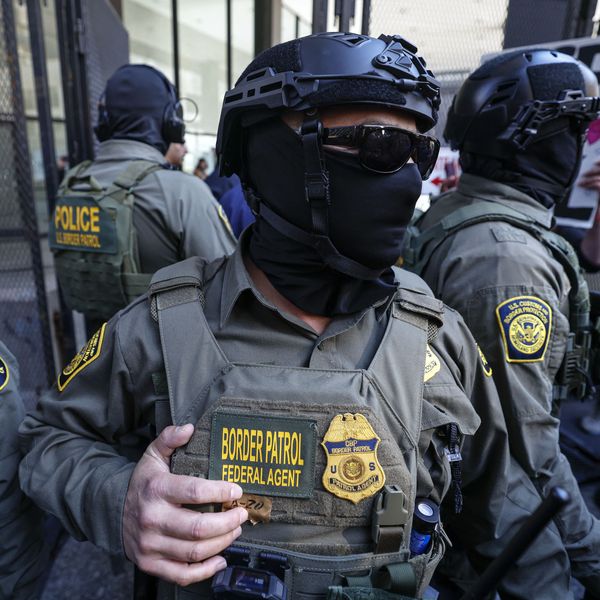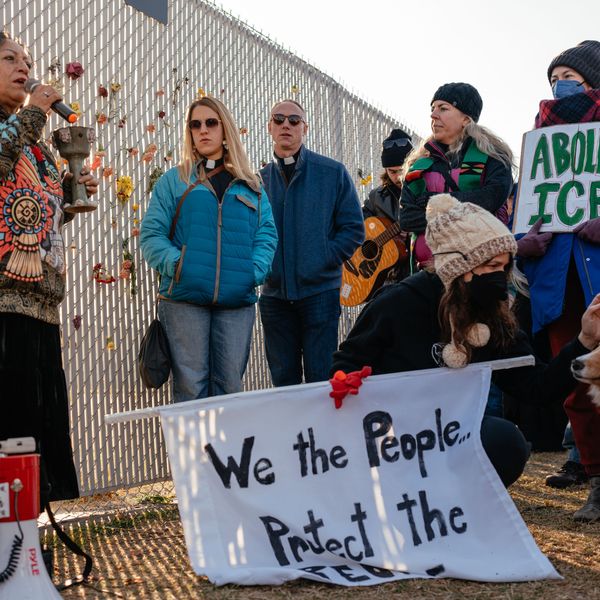“I must say,” Donald Trump commented, “I wish we had an occupying force.” It was June 1, 2020. The president, then in his first term in office, was having a phone call with the nation’s governors to discuss the ongoing Black Lives Matter (BLM) protests taking place nationwide in response to the murder of George Floyd at the hands of a Minneapolis policeman. He was urging the governors to call in the National Guard in response to BLM protests in their states. Otherwise, he threatened he would do so himself. “You have to dominate,” he told them, while labeling the protesters “terrorists.” Otherwise, he claimed, “they are going to run over you.”
Later that morning, Trump left the White House and took his infamous walk through Lafayette Park, where members of the Washington National Guard, the FBI, the Drug Enforcement Administration, and several other agencies, joined by guard units from a number of states, confronted protesters. As I recounted in my book Subtle Tools, “Protesters threw eggs, candy bars, and water bottles, while law enforcement shot rubber bullets, launched pepper balls, and fired tear gas into the crowd.”
Several weeks later, protests in Portland, Oregon, tested the president’s resolve to send in an “occupying force.” Although he didn’t then go as far as to send in the National Guard, as he had threatened in that phone meeting, he did deploy federal agents to counter the protesters without consulting the governor of that state. Seven hundred and seventy-five Department of Homeland Security agents from U.S. Immigration and Customs Enforcement, U.S. Customs and Border Protection, and elsewhere appeared on the streets of Portland, authorized by a presidential edict to protect federal buildings. As if to intentionally blur the borderline between military and civilian authorities, the federal agents arrived dressed in black military-looking uniforms without identifying insignia and drove unmarked vehicles. The administration justified the deployment by arguing that local law enforcement was unable to effectively control the protests.
Not surprisingly, Oregon Governor Kate Brown and Portland Mayor Ted Wheeler protested, claiming that local law enforcement was perfectly capable of handling the protests without federal aid, and that the presence of federal agents, with their aggressive tactics, including the use of tear gas and rubber bullets, had only provoked the protesters, making the situation much worse.
Sound familiar? Fast forward to today in Los Angeles.
Donald Trump is once again president, and immigration raids across the country are hurrying to meet the White House target of 3,000 arrests per day. This time around, Los Angeles has become the focal point of the resulting battle over federal versus state authority. In early June, responding to an outbreak of protests challenging the administration’s brutal immigration raids, Trump sent 700 active-duty Marines and 4,100 National Guard into that city to counter the protesters. Los Angeles Mayor Karen Bass, California Governor Gavin Newsom, and California Attorney General Bonta have protested resoundingly, claiming, like their Portland counterparts, that the deployment was unnecessary and counterproductive. Mayor Bass has maintained that the local authorities “had the situation under control,” concluding that “there was no need for the National Guard.” Summing up the consequences of the deployment, Governor Newsom considered them to be “intentionally causing chaos, terrorizing communities, and endangering the principles of our great democracy. It is an unmistakable step toward authoritarianism.” Attorney General Bonta echoed Newsom by insisting that the troops were instigating violence, not defusing it, and suing the Trump administration (unsuccessfully so far) for illegally taking over a state National Guard.
Where all of this may be headed is anyone’s guess, but Portland’s attempts in 2020 to fight back against the deployment of federal agents, despite the wishes of local authorities, provide some guidance about what to expect, as well as lessons learned when it comes to the role of the courts, of dissent by local and state leaders, and of the path down which American law may be headed in relation to the president’s ability to usurp the power of local authorities.
The Law
The battle over federal versus state authority is rooted in laws pertaining to presidential powers. The Posse Comitatus Act, as former United States Attorney Joyce Vance explains, “prohibits the federal government from using the military inside of the domestic United States for law enforcement, absent truly compelling circumstances.” But there are exceptions. Title 10 of the U.S. Code fleshes them out, authorizing the president to federalize the National Guard and deploy it to a state in rare instances of invasion, rebellion, or the need to “execute [federal] laws.”
In Portland in 2020, President Trump labelled the protesters “terrorists” and threatened to bring in the National Guard if the protests didn’t stop. Yet days later, he pulled back from that threat, telling George Stephanopoulos on ABC News that such a move would have violated the law. “We have to go by the laws,” he said then. “We can’t move in the National Guard. I can call insurrection but there’s no reason to ever do that, even in a Portland case.” He further concluded that “we can’t call in the National Guard unless we’re requested by a governor.”
My, how things have changed!
On June 7th, Trump issued a memorandum declaring his authority to deploy both the National Guard and the armed services. “In light of these incidents and credible threats of continued violence,” the memo authorized the secretary of defense to coordinate with governors to deploy both the National Guard and “any other members of the regular Armed Forces as necessary to augment and support the protection of Federal functions and property in any number determined appropriate in his discretion.” In other words, Secretary of Defense Pete Hegseth was given unprecedented authority to direct events on the home front, challenging the Posse Comitatus Act’s prohibitions.
Since then, 4,100 National Guardsmen and 700 Marines have arrived in Los Angeles. Their presence has been notably aggressive. Meanwhile, Department of Homeland Security agents have swarmed the streets, local employment places, and immigration offices, not wearing identifying insignia (as occurred in Portland). As Nick Turse reported at The Intercept, “Since June 8, there have been 561 arrests related to protests across Los Angeles; 203, for failure to disperse, were made on the night of June 10, after Trump ordered in the National Guard and Marines.” Meanwhile, Trump used the growing conflict to threaten Governor Newsom with arrest.
Justifying his deployments, the president labelled the protesters “insurrectionists,” laying the groundwork for invoking the Insurrection Act, which, as Joyce Vance explains, “allows the military to be used for domestic law enforcement, but — and it’s an important caveat — only to restore order.”
For help in pushing back against the deployments, California officials, like their Portland predecessors, have turned to the courts. This time around, however, the Trump administration has revised its reading of what is lawful and, so far, the judiciary seems to be bending the president’s way.
The Courts
On June 9th, Governor Newsom filed suit in federal court, claiming that the deployment of the Guard and the Marines violated the Constitution and exceeded the president’s Title 10 authority. The suit argued that the deployments were unwarranted and the administration had failed to try to coordinate with the governor. California Attorney General Rob Bonta elaborated on the limitations of the law: “Let me be clear: There is no invasion. There is no rebellion. The President is trying to manufacture chaos and crisis on the ground for his own political ends. Federalizing the California National Guard is an abuse of the President’s authority under the law — and not one we take lightly. We’re asking a court to put a stop to the unlawful, unprecedented order.”
In 2020, the Oregon attorney general had filed suit in federal court in response to the actions of the federal agents. As the New York Times reported, “The lawsuit said federal agents were violating the First, Fourth, and Fifth Amendments to the Constitution by denying the right to peacefully protest, failing to provide due process and conducting unreasonable searches and seizures.” Ultimately, the federal judge dismissed the case, claiming that “the attorney general’s office did not have standing to bring the case because it had not shown that the issue was ‘an interest that is specific to the state itself.’” The Oregon court also shied away from tackling the larger question of what powers the federal government actually had in such situations.
Suits brought by private parties, as well as the American Civil Liberties Union, on behalf of individuals (journalists in particular), who were injured, harassed, or “abducted” by federal agents were more successful. Initially, a judge expanded a temporary restraining order (TRO) from local law enforcement to federal agents, blocking the use of tear gas and projectiles against journalists. As the suit progressed, more weapons in the federal agents’ arsenal, including rubber bullets, were prohibited.
When the president asked for the TRO to be removed, the judge not only refused, but levied a requirement that government agents wear identifying insignia — an effort to introduce a measure of accountability into the conflict on the ground.
On appeal, the Ninth Circuit Court of Appeals raised the larger issue of federal versus local authority, resoundingly rejecting the legality of the presence of federal agents in Portland, while agreeing with the lower court’s finding of “a disturbing pattern of unwarranted force by federal agents.” That court not only reinstated the TRO against federal agents attacking journalists but underscored the fact that federal agents had gone beyond protecting federal buildings to actively confronting protesters, while widening the “perimeter” in which they could act outside those buildings and so wrongfully overstepping the authorities expressly reserved for local law enforcement.
And at that time, there was also help from within Trump’s circle. In a settlement arranged between Oregon Governor Kate Brown and Vice President Mike Pence’s staff, federal law enforcement officers were indeed replaced with members of the Oregon state police. As Nik Blosser, Brown’s chief of staff and one of the negotiators, pointed out recently, referring to Vice President Pence, “There was at least someone in the administration that knew that this violence needed to come to an end. I’m not sure who is there to negotiate with now.”
Today, in Los Angeles, the courts are similarly engaged in a suit over the administration’s deployment of federal agents to counter protests. So far, however, the outcome is trending very differently. Earlier in the month, a federal judge issued a TRO against the National Guard in that city. In a 46-page ruling, Judge Charles Breyer, the brother of retired Supreme Court justice Stephen Breyer, rejected the government’s characterization of the protests as “a rebellion” and excoriated the president for assuming powers beyond his constitutional and statutory authority. “That’s the difference between a constitutional government and King George” was the way he put it. In addition, Judge Breyer returned the authority to deploy the National Guard to California rather than the federal government.
The administration immediately appealed. As in the Portland case, the appellate court is once again the Ninth Circuit. On June 18th, there was a hearing before a panel of three judges, two of them Trump appointees and one a Biden appointee. Repeatedly, the judges seemed to reject the notion that the law requires the active involvement of the governor in the decision to deploy such troops, appearing to side with the federal government lawyer, who told the judge again and again, “Our position is this is not subject to judicial review.” In other words, the president should have free rein to do as he pleases.
In their ruling, the appellate judges agreed with Trump and not with the state of California, overruling the district court judge and unanimously agreeing that the president had acted lawfully and that his failure to notify the governor before deploying those troops was not grounds for obstructing the president’s order. In other words, he could indeed keep control of the troops in L.A.
In short, the case has taken us another step down the road to the “maximalist” view of executive power. The ruling suggests that last year’s Supreme Court immunity decision, allowing a president to do more or less whatever he wants while in office without fear of retribution, was indeed a game changer. As a reminder, in July 2024, while Trump was running for office a third time, the court ruled that, “under our constitutional structure of separated powers, the nature of Presidential power entitles a former President to absolute immunity from criminal prosecution for actions within his conclusive and preclusive constitutional authority. And he is entitled to at least presumptive immunity from prosecution for all his official acts.” The court then added, “There is no immunity for unofficial acts.”
In the context of recent events in Los Angeles, rather than immunity for criminal activity, it suggests that the Supreme Court might indeed support immunity from legal pushback for acts committed at the state level. And that would, of course, remove yet another of the checks and balances that once underlay the protections against untethered presidential power in the American system of government.
A Genuinely Frightening Moment
How this will play out at the Supreme Court the next time around is anyone’s guess and may turn on the issue of whether that court assesses that there really was a rebellion in Los Angeles — the government’s premise for bringing in federal troops. Nonetheless, this should certainly be considered a frightening moment. After all, that presidential memorandum authorizing the federal deployments to L.A. was in no way limited to California. In fact, there was no geographical specificity to it at all and no specific type of protest named in the memo. It was a blanket authorization for deploying federal troops, based on unspecified acts of violence, disorder, and protests. If California is a sign of the future, it seems ever clearer that the courts have little appetite for standing in the way of this president. In addition, as loyalty to him is the first requisite of government officials, any pushback from within the ranks of his administration seems essentially inconceivable.
So here we are, once again learning that the restraints Americans could rely upon in the past are fast disappearing. And while protests from democratic leaders abound, it’s the courts that, at this moment, hold the power.
It’s tempting to point to the moments in recent times when we should have seen this coming — the growing powers granted to the president in the name of the Global War on Terror, the unchecked ability of the president to repeatedly make acting appointments and fire those in his cabinet who oppose his will, the coopting of members of Congress through threats of primarying them out of office or grants of vast amounts of money should they demonstrate sufficient loyalty to the president.
But as it stands, this is probably not the time to focus on who’s to blame in the past. Instead, it’s time to consider the future and our power to strengthen the fundamentals of our democracy before all is lost. Only if our trust in the law and the courts is restored will we truly be able to turn our thoughts to the mistakes and missed opportunities of what by then would be the painful past.





